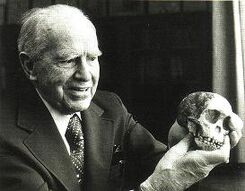
Raymond Dart with Taung skullTemplate:Deletable image-caption
Raymond Dart (February 4 1893 – November 22 1988) was an Australian anatomist and anthropologist best known for his discovery in 1924 of a fossil of Australopithecus (extinct hominids closely related to humans) at Taung in Northwestern South Africa. The son of a farmer and tradesman, he was married twice and had two children.
Early life
He was born in Toowong, Queensland, Australia and studied at Ipswich Grammar School, the University of Queensland, University of Sydney and University College, London, before taking a position as head of the newly established department of anatomy at the University of Witwatersrand in Johannesburg, South Africa in 1922.
The discovery
In 1924, a limestone quarry owner at Taung shipped Dart a box of fossiliferous rock. Digging around in it, Dart found an endocranial cast, and then its matching fossil skullpiece. (Source: Lucy) Dart examined this Taung Child fossil, as it came to be known, and pronounced it to be a new species, Australopithecus africanus. Dart postulated his new find to be a missing link between apes and humans because of its small brain size, but relatively human-like dentition and a probable upright posture.
Dart's discovery and Dart himself were initially heavily criticized by the eminent anthropologists of the day, most notably Sir Arthur Keith who claimed the Taung Child to be nothing other than a juvenile gorilla. Because the specimen was indeed a juvenile, there was a lot of room for interpretation, and because African origins for mankind and the development of bipedalism before a human-like brain were both inconsistent with the prevailing evolutionary notions of the time, Dart and his Child became the butt of many attacks.
Vindication and disagreement
Dart's closest ally was Robert Broom, whose discoveries of further australopithecines, as well as Wilfrid Le Gros Clark's support, eventually vindicated Dart. So much so that in 1947, Sir Arthur Keith said "...Dart was right, and I was wrong."
Not all of Dart's ideas are accepted today. His assertion that gazelle long-bones found in association with Australopithecus africanus were used as tools is unproven and largely dismissed. Dart also originated the killer ape theory. Although some other anthropologists, notably Robert Ardrey, defended and further developed the theory, it is still widely questioned.
His legacy
The Institute for the Study of Man in Africa was established in 1956 at Witwatersrand in his honor.[1]
Dart continued in his position as director of the School of Anatomy at University of Witwatersrand, Johannesburg, until 1958. There he worked with Phillip Tobias, who continues his work in the study of the Cradle of Humankind and other paleoanthropological sites. In 1959, an autobiographical account of Dart's discovery was published, Adventures with the Missing Link.
Bibliography
- Dart R.A. (1925): Australopithecus africanus: the man-ape of South Africa. Nature, 115:195-9 (the original paper communicating the Taung finding, in PDF format).
- Dart, R.A. (1953): "The Predatory Transition from Ape to Man." International Anthropological and Linguistic Review, 1, pp. 201-217.
- Dart, Raymond and Craig, Dennis (1959): Adventures with the Missing Link. New York: Harper & Brothers (autobiography).
- Fagan, Brian. The Passion of Raymond Dart. Archaeology v. 42 (May-June 1989): p. 18.
- Johanson, Donald & Maitland Edey. Lucy: The Beginnings of Humankind. New York: Simon & Schuster, 1990 ISBN 0-671-25036-1
- Alexander Murray, ed. (1996): Skill and Poise: Articles on skill, poise and the F. M. Alexander Technique. Collection of Raymond Dart's papers. Hardcover, 192+xiv pages, b/w illustrations, 234 x 156 mm, index, UK, STAT Books.
References
- ↑ Institute for the Study of Man in Africa. Objectives & Vision, Background Information. ISMA website.
See also
- Hominidae
- Human evolution
- List of fossil sites (with link directory)
- List of hominina fossils (with images)
External links
- Essay by C.K. Brain, "Raymond Dart and our African origins," accompanying the reprint of Raymond Dart's 1925 Nature article in A Century of Nature: Twenty-One Discoveries that Changed Science and the World, Laura Garwin and Tim Lincoln, eds.
- Biography of Raymond Dart on Minnesota State University, Mankato EMuseum website
- Biography of Raymond Dart in the TalkOrigins Archive.